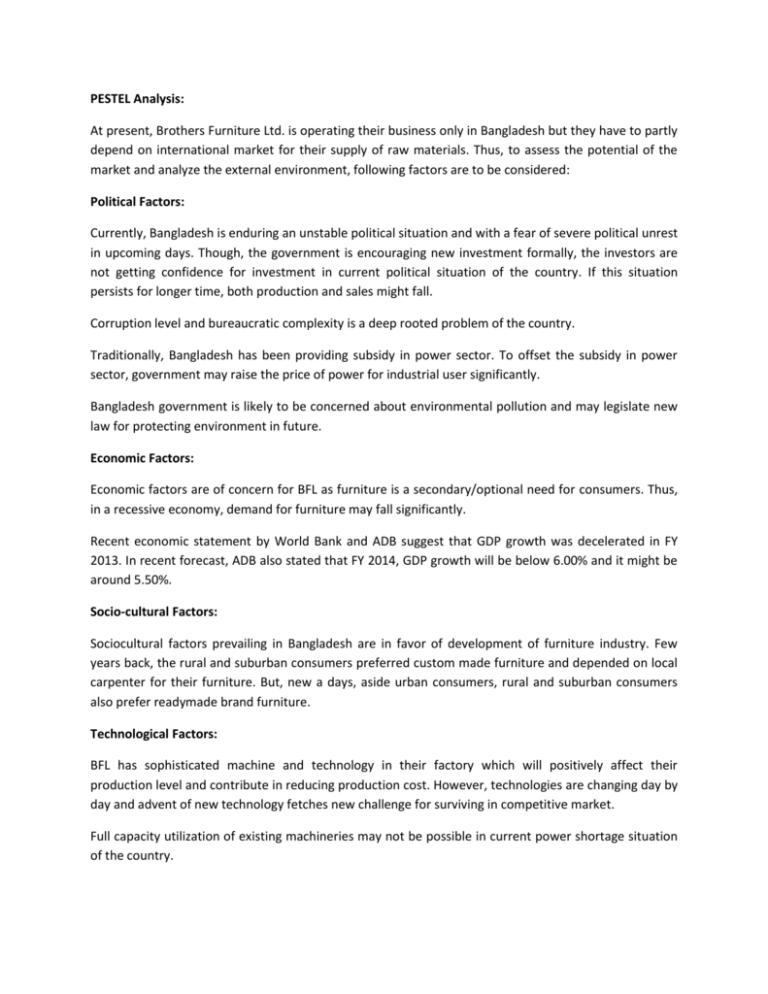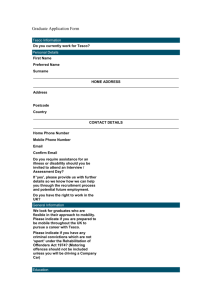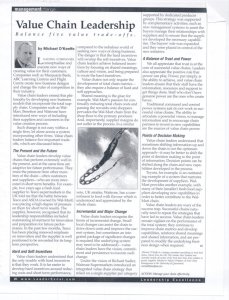PESTEL Analysis: At present, Brothers Furniture Ltd. is operating
advertisement

PESTEL Analysis: At present, Brothers Furniture Ltd. is operating their business only in Bangladesh but they have to partly depend on international market for their supply of raw materials. Thus, to assess the potential of the market and analyze the external environment, following factors are to be considered: Political Factors: Currently, Bangladesh is enduring an unstable political situation and with a fear of severe political unrest in upcoming days. Though, the government is encouraging new investment formally, the investors are not getting confidence for investment in current political situation of the country. If this situation persists for longer time, both production and sales might fall. Corruption level and bureaucratic complexity is a deep rooted problem of the country. Traditionally, Bangladesh has been providing subsidy in power sector. To offset the subsidy in power sector, government may raise the price of power for industrial user significantly. Bangladesh government is likely to be concerned about environmental pollution and may legislate new law for protecting environment in future. Economic Factors: Economic factors are of concern for BFL as furniture is a secondary/optional need for consumers. Thus, in a recessive economy, demand for furniture may fall significantly. Recent economic statement by World Bank and ADB suggest that GDP growth was decelerated in FY 2013. In recent forecast, ADB also stated that FY 2014, GDP growth will be below 6.00% and it might be around 5.50%. Socio-cultural Factors: Sociocultural factors prevailing in Bangladesh are in favor of development of furniture industry. Few years back, the rural and suburban consumers preferred custom made furniture and depended on local carpenter for their furniture. But, new a days, aside urban consumers, rural and suburban consumers also prefer readymade brand furniture. Technological Factors: BFL has sophisticated machine and technology in their factory which will positively affect their production level and contribute in reducing production cost. However, technologies are changing day by day and advent of new technology fetches new challenge for surviving in competitive market. Full capacity utilization of existing machineries may not be possible in current power shortage situation of the country. Environmental Factors: To save the environment from pollution, in Bangladesh, there have pressure from government and society. BFL has to be concerned about environmental pollution by their factory. Their present factory location, Shahzadpur, Gulshan is a densely populated residential area. This type of industry should not be located in residential area. BFL should consider about transfer of their existing factory. Legal Factors: Various government legislations and policies have a direct impact on the performance of furniture industry. For instance, revised tax and vat policy, raising duty of imported raw materials may affect the industry. 3.0 INDUSTRY ANALYSIS: PORTER’S FIVE FORCES 3.1 Threat of New Entrants The UK grocery market is primary dominated by few competitors, including four major brands of Tesco, Asda, Sainsbury’s and Safeway that possess a market share of 70% and small chains of Somerfield, Waitrose and Budgens with a further 10%. Over the last 30 years, according to Ritz (2005), the grocery market has been transformed into the supermarket-dominated business. Majority of large chains have built their power due to operating efficiency, one-stop shopping and major marketing-mix expenditure. This powerful force had a great impact on the small traditional shops, such as butchers, bakers and etc. Hence, nowadays it possesses a strong barrier for new companies who desire to enter the grocery market. For instance, it becomes rather difficult for new entrants to raise sufficient capital because of large fixed costs and highly developed supply chains. This is also evident in huge investments done by large chains, such as Tesco, in advanced technology for checkouts and stock control systems that impact new entrants and the existing ones. Other barriers include economies of scale and differentiation (in the provision of products or services with a higher perceived value than the competition) achieved by Tesco and Asda seen in their aggressive operational tactics in product development, promotional activity and better distribution. 3.2 Bargaining Power of Suppliers This force represents the power of suppliers that can be influenced by major grocery chains and that fear of losing their business to the large supermarkets. Therefore, this consolidates further leading positions of stores like Tesco and Asda in negotiating better promotional prices from suppliers that small individual chains are unable to match Ritz (2005). In return, UK based suppliers are also threatened by the growing ability of large retailers to source their products from abroad at cheaper deals. The relationship with sellers can have similar effects in constraining the strategic freedom of the company and in influencing its margins. The forces of competitive rivalry have reduced the profit margins for supermarket chains and suppliers. 3.3 Bargaining Power of Customers Porter theorized that the more products that become standardized or undifferentiated, the lower the switching cost, and hence, more power is yielded to buyers Porter M. (1980). Tesco’s famous loyalty card – Clubcard remains the most successful customer retention strategy that significantly increases the profitability of Tesco’s business. In meeting customer needs, customizing service, ensure low prices, better choices, constant flow of in-store promotions enables brands like Tesco to control and retain their customer base. In recent years a crucial change in food retailing has occurred due to a large demand of consumers doing the majority of their shopping in supermarkets that shows a greater need for supermarkets to sell non-food items. It has also provided supermarkets with a new strategic expansion into new markets of banking, pharmacies, etc. Consumers also have become more aware of the issues surrounding fairer trade and the influence of western consumers on the expectations and aspirations of Third World producers. Ecologically benign and ethically sound production of consumer produce such as tea, coffee and cocoa is viable, and such products are now widely available at the majority of large chains. 3.4 Threat of Substitutes General substitution is able to reduce demand for a particular product, as there is a threat of consumers switching to the alternatives Porter M. (1980). In the grocery industry this can be seen in the form of product-for-product or the substitute of need and is further weakened by new trends, such as the way small chains of convenience stores are emerging in the industry. In this case Tesco, Asda and Sainsbury’s are trying to acquire existing small-scale operations and opening Metro and Express stores in local towns and city centres Ritz (2005). 3.5 Bargaining Power of Competitors The grocery environment has seen a very significant growth in the size and market dominance of the larger players, with greater store size, increased retailer concentration, and the utilisation of a range of formats, which are now prominent characteristics of the sector. As it was mentioned above, the purchasing power of the food-retailing industry is concentrated in the hands of a relatively small number of retail buyers. Operating in a mature, flat market where growth is difficult (a driver of the diversification into non-food areas), and consumers are increasingly demanding and sophisticated, large chains as Tesco are accruing large amounts of consumer information that can be used to communicate with the consumer Ritz (2005). This highly competitive market has fostered an accelerated level of development, resulting in a situation in which UK grocery retailers have had to be innovative to maintain and build market share. Such innovation can be seen in the development of a range of trading formats, in response to changes in consumer behaviour. The dominant market leaders have responded by refocusing on price and value, whilst reinforcing the added value elements of their se







